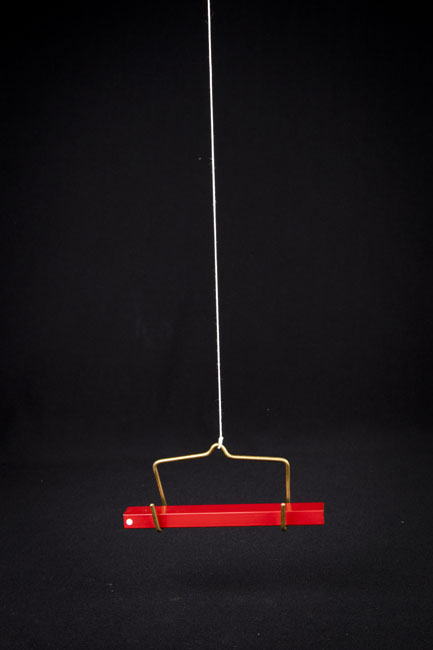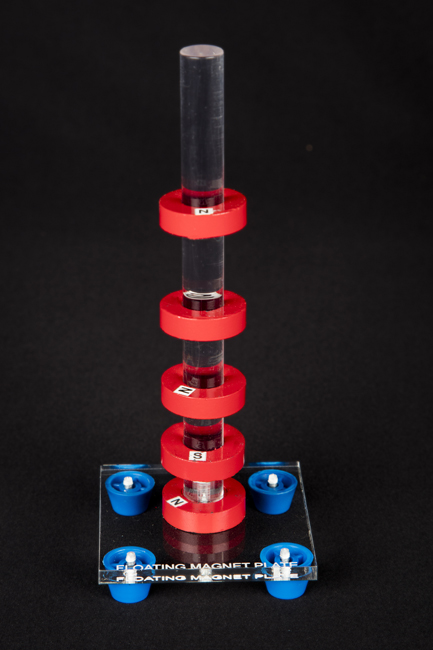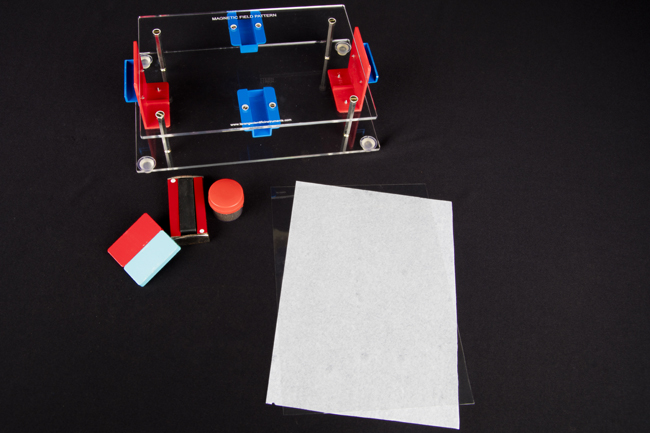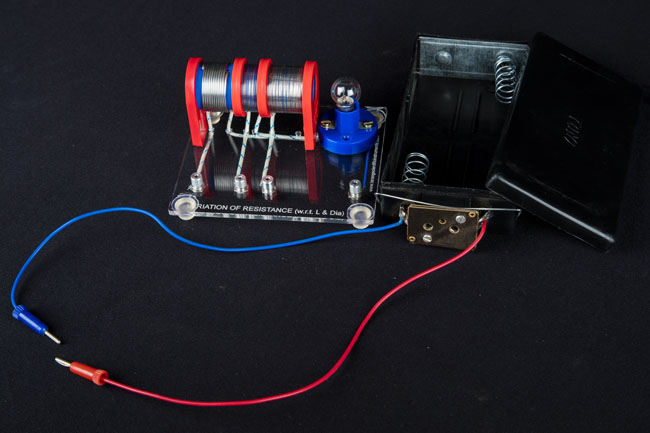| |
| Magnetism & Electricity |
Page II |
| |
| Load Stone |
|
 |
|
The load stone is an Oxide of iron (Fe3O4). This a natural magnet. Helps you to study the characteristics of a natural magnet. When suspended using string it oscillated until its North and South axis align with magnetic field of the earth.
|
 |
|
|
| |
| |
| Stirrup (with 4" bar magnet) |
|
 |
|
Supports for bar magnets. Allows magnet to hang freely, when magnet placed on this support and suspended freely using thread, it helps us to study the directional property of magnets. Comes with 4" lenght, 1/2 " width , 1/4" thickness, pair of bar magnets. |
 |
|
|
| |
| |
| Floating Magnet Set |
 |
 |
|
| The model comes with 5 ring magnets (25 mm diameter and 7 mm thickness) and acrylic rod mounted on a base. When magnets are inserted through the rod with their like poles facing each other, they simply float in air one over the other. A good new substitute to show attraction and repulsion properties of magnets. |
 |
|
|
| |
| |
| Magnetic Field Pattern |
|
 |
|
| This model allows you to study the magnetic field due to various arrangements of magnets. After placing the magnet in the proper place if you sprinkle iron filings over the platform the iron filing align with the direction of the magnetic field and revels the fired pattern. Two bar magnets, two rectangular magnets and iron filing are part of the kit. |
 |
|
|
| |
| |
|
| |
| |
| Electromagnet |
|
 |
|
This model allows you to see the action of an electromagnet. When the 'L' shaped 4 mm red coloured iron rod is placed in the alumminium stand and current is allowed to pass through the copper coil with iron core inside, the coil gets magnetised and becomes electromagnet. As a result, it attracts the iron rod which is in front of it. You can also demonstrate that repulsion is the sure test of magnetism not the attraction in the same model. For that you need to place both 'L' shaped 4 mm rod inside the copper wound coil and allow the current to flow through it.
|
 |
|
|
| |
| |
| Field Due To Solenoid |
 |
 |
|
This model allows you to explore the magnetic field pattern produced by a solenoid (or an electromagnet) when current is passed through it. You can also compare this magnetic field pattern to the magnetic filed pattern produced by a bar magnet. Sprinkle iron filing on the platform above bar magnet and tap it gently. You will get a fired pattern due to bar magnet. Now sprinkle iron filing on the platform above the solenoid and pass current (12v, 3amp) through the solenoid. The iron filings align according to the direction of the field.
|
 |
|
|
| |
| |
| Relay Circuit |
|
 |
|
This model demonstrates how switching one circuit causes one or more other circuits to be switched. When you push the bell push button, the first circuit is complete and the steal strip will be attracted towards the electromagnet. This make the strip to touch the bare wire. As a result the second circuit gets completed and the bulb in the second circuits glows. |
 |
|
|
| |
| |
|
| |
| |
|
| |
| |
| Ampere Model |
|
 |
|
Useful for the study of the direction of the magnetic field around a straight conductor carrying current. The apparatus comes with a 'L' shaped brass rod fixed on a plastic base, with circular plastic plate around the vertical portion of the bar. The ends of the rod are provided with connecting leads. By placing small compasses near and around the vertical portion of the rod (on the circular platform), and passing current through the rod one can study the direction of the filed around the Straight conductor. |
 |
|
|
| |
| |
|
| |
| |
|
| |
| |
| Tangent Galvanometer |
|
 |
|
This simple model allows you to study functioning of tangent galvanometer. A compass needle is pivoted at the center of circular circle coil of diameter 136mm. When current is pass through the coil using it produces magnet field and the compass will show the deflection depending on the strength of the current through the coil. The current flowing through the coil can be adjusted using variable not which is connected in series with coil. |
 |
|
|
| |
| |
|
| |
| |
|
| |
| |
| Simple Circuit Kit |
|
 |
|
This kit consists of two single cell holders, 3 bulb holders, 3 bulbs, a switch and connecting wire. One can do the experiments related to Simple circuit, Open circuit, Closed circuit, resistance in series, resistance in parallel, cells in series and cell in parallel etc., |
 |
|
|
| |
| |
|
| |
| |
|
| |
| |
| Variation Of Resistance ( With Length And Diameter ) |
|
 |
|
An attractive model to demonstrate the resistance of a conductor decreases with increase in diameter and resistance of a conductor increases with increase in length of the conductor. The apparatus consist of 3 coils which are permanently mounted on a clear plastic base with connecting pins. In that first and second coils are of same length but of different diameter and second and third coils are of same diameter but of different lengths.
· An Indicator lamp is also provided, on the base.
· The apparatus comes with 4 cell holder box for use of 6V supply. |
 |
|
|
| |
| Page II |
| |
